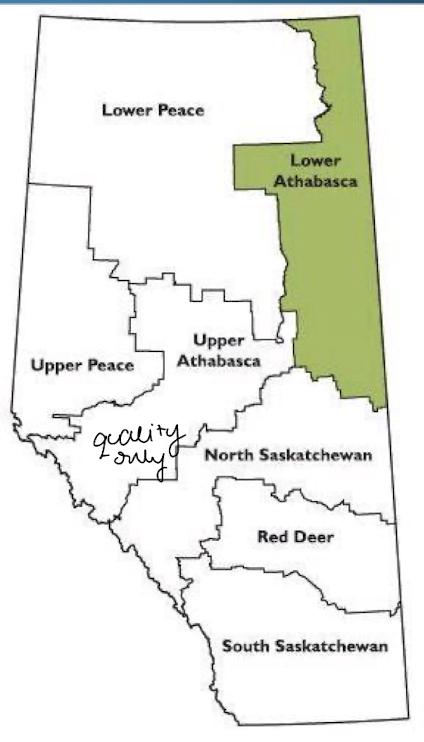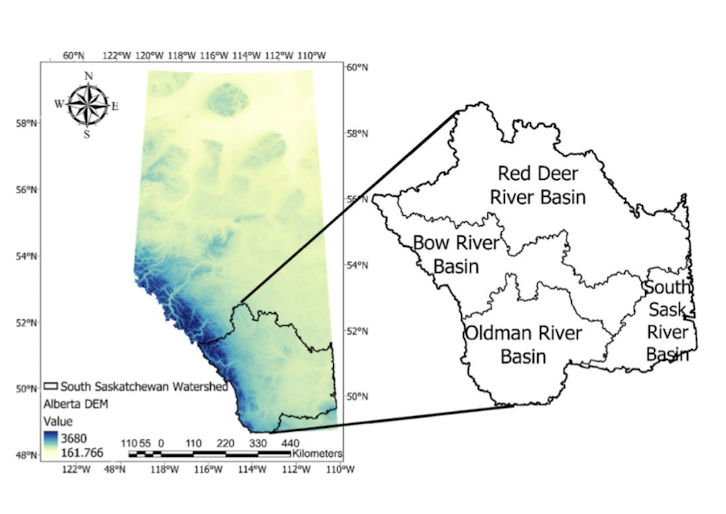Athabasca watershed council
1/23
There's no tags or description
Looks like no tags are added yet.
Name | Mastery | Learn | Test | Matching | Spaced |
|---|
No study sessions yet.
24 Terms
water for life strategy 2003
three main goals are safe/secure drinking water supplies (social)
healthy aquatic ecosystems (environmental)
and reliable quality supplies for a sustainable economy (economic)
water management drivers
increasing pop growth, ag and industrial expansion, drinking water contaminants, 2001 drought and legal risk with junior water licenses
basically increase demand for pressure on water quality supplies - need to manage risk
what’s missing from WFL
indigenous consultation, climate change impacts?
adaptation and revisiting and changing policies
watershed planning and advisory councils
shared governance opportunity
gov and stakeholders share respons and govt retains legislative accountability
collaborative goals and problem solving built on trust
watershed stewardship groups in watershed management?
implementing ground action
stewardship and best practices, education and literacy and research to fill in gaps
watershed planning and advisory council in watershed management?
strategic plans, incentives and disincentives, monitoring and assessments and research to fill in gaps, planning, reporting, water literacy
there are 11 councils in alberta and they have iterative, adaptive, inclusive and continuous improvement throughout their work
GOA in watershed management?
policy direction, enabling legislation, regulations and enforcement, and monitoring and assessments
alberta water council in watershed management?
aiding in provincial policy direction
how do WPAC boards work?
representation from major stakeholders inclusing - governments (incl indigenous), NGOs from conservation, academia to recreation and public, and finally industry from forestry, oil and ggas, ag, mining, utilities
advisory
stakeholders
financial incentive to those impacted
from opposition to in agreement - all sides
why a watershed approach?
water cycle and climate change
many axes from upstream/downstream to highest and lowest sources and then surface and gw interactions
includes rivers, lakes, aquifers
indicator of our land use - place and people based - who is actually in the land
what issues do WPACs address?
water quality - surface and GW monitoring, pollution, source water protection
water quantity - allocations, consumption, conservation and re-use
ecosystem health - instream flow needs, biodiversity, SARA, invasive species, wetlands etc
landcover/use - cumulative effects of major industry
policy/plan integration, and climate change and its effects
athabasca watershed council
2009, a society and registered charity, has staff/summer students/interns, board seats and members, guided by vision, mission, values, strategic goals
consensus based, authority is at the table
completed a state of watershed report, identified different issues across watershed, prepared IWMP
the athabasca watershed
24% of alberta, but <4% of ab’s population
vast land diversity, lots of industry, parks, recreation, and new activities such as geothermal, minerals, etc
athabasca IWMP
road map for watershed management, advice for how to achieve water for life goals, implementing plan currently
athabasca watershed IWMP goals
goals includes safe/secure drinking water,
healthy/diverse ecosystems,
balancing social/economic/environmental,
natural land cover - mitigated land use pressure,
TEK informs decision making/planning,
policies aligned for health,
impacts of climate change inform,
sub basin and lake assessment are supported
IWMP learnings
20 strategies and 51 actions requires lots of time and resources
values are different across watershed
need to find local solutions and local working groups
collaborations are key
integrated land and water management
many scales - from advisory plans (watershed to lake)
and then they will influence statutory plans like provincial, regional, municipal and then resource plans
lower athabasca regional plan
legislated plan sets regional land use goals
air, water, land/biodiv management frameworks manage cumulative effects
red, yellow, green monitoring systems to see where limits are at - industry cautions
and this triggers a management response

south sask river basin management plan
regional scope of agricultural area
plan to balance social, land use and environmental health
water withdrawals - there are limits to the resource here, a closed basin to new water allocations
the 2024 drought and water sharing agreements

lac la biche sub-basin
to protect and improve water quality and balance econ/social/enviro
lake is nutrient rich and worsening
need to integrate statutory land use bylaws, statutory tools such as laws, nature based solutions, limits, reserves
G&S cattle and pigeon lake
watershed approach informing land use regulatory process
feedlot process expansion of 4000 head denied
but owners and municipalities worked to create a IWMP
challenges to IWMP
large landscape! different issues across and hard to get people on the same table
lack of comparable data, synthesis, translation, etc
need proactive vs reactive tools
opportunities to IWMP
new tools like GIS, drones, remote sensing, models, AI etc
recognition for nature based solutions to slow the flow